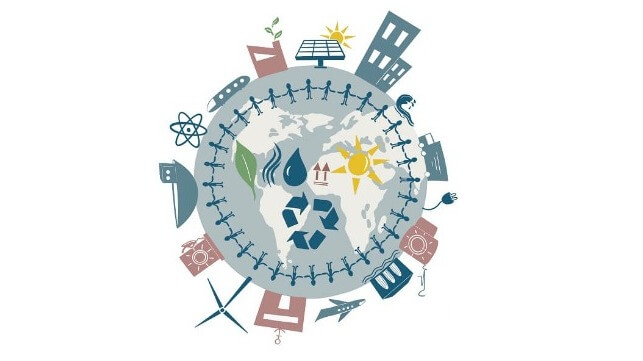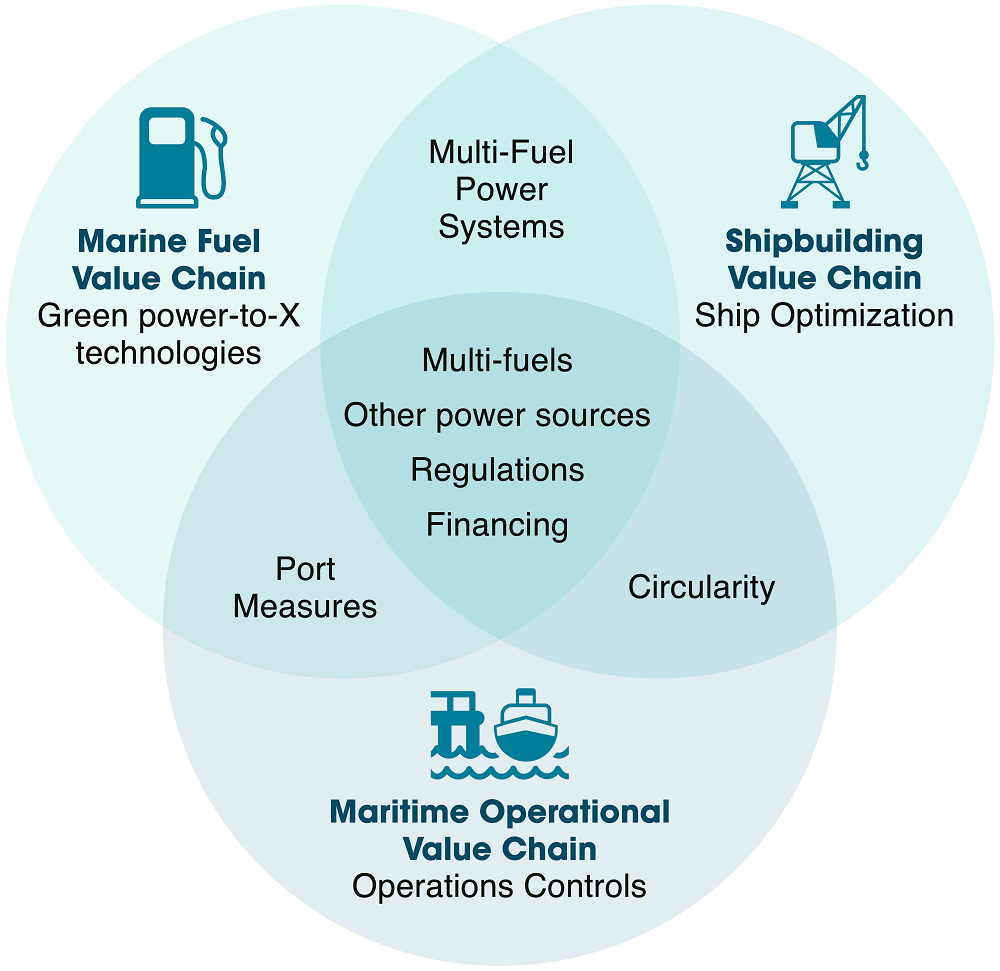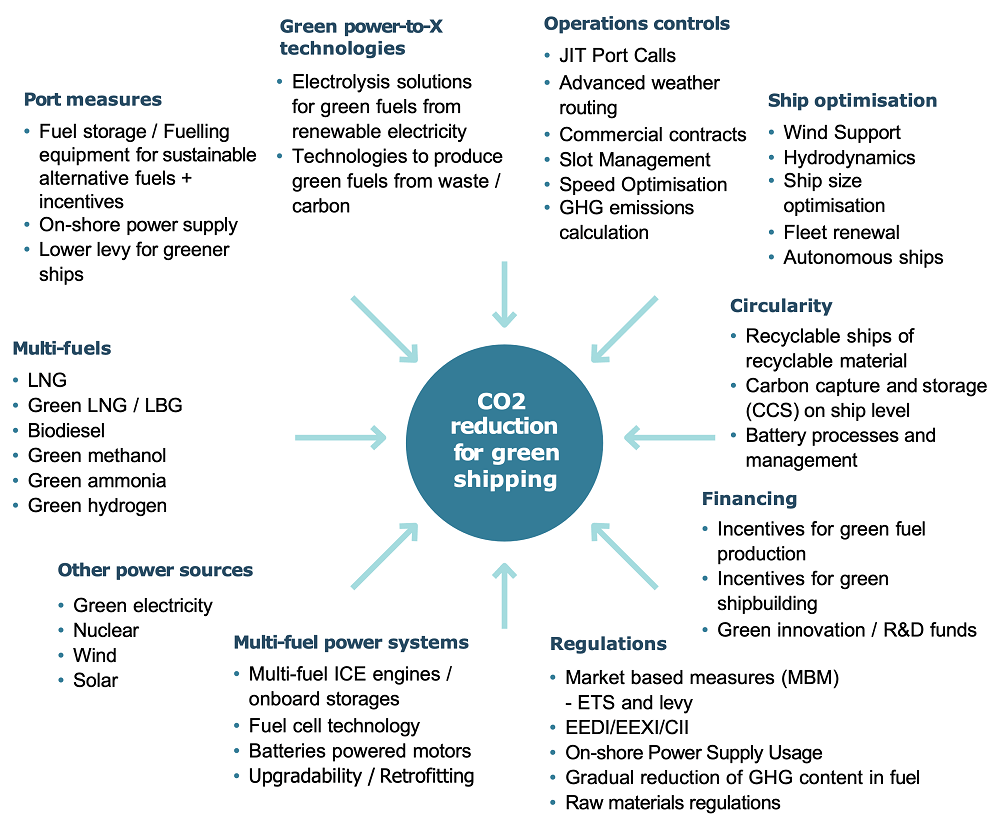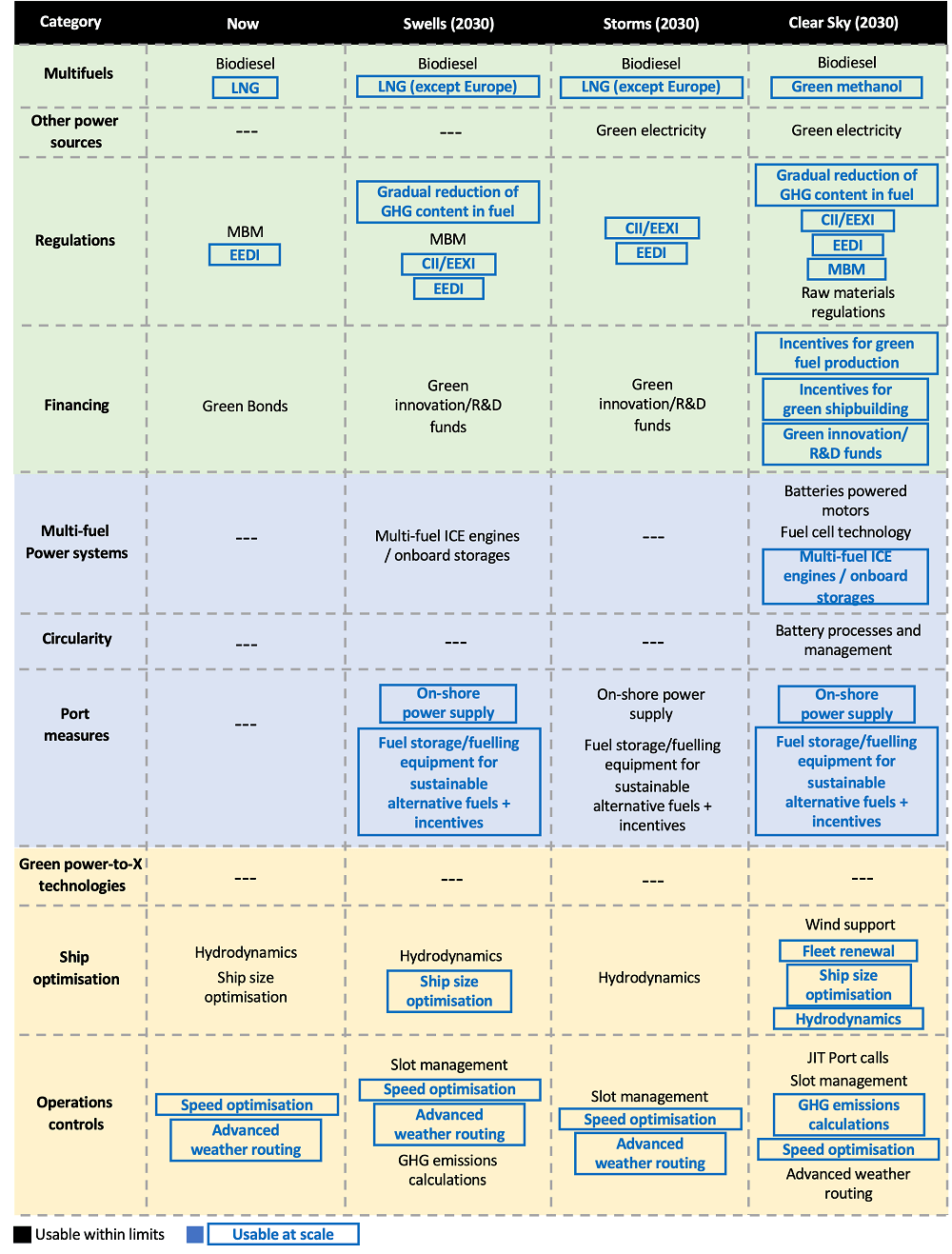Enablers for Decarbonizing the Maritime Industry: Playbook Part 3

[By Mikael Lind, Wolfgang Lehmacher, Louise De Tremerie, Frank Dubielzig, Ellinor Forsström, Paul Holthus, Andrea Morgante, Sukhjit Singh, and Lina Tenenbaum]
The journey towards a sustainable maritime shipping sector is driven by enablers spread across multiple areas. The decarbonization enablers include more sustainable fuels and other green sources of power, strong regulations that set an ambitious framework, bold financing for sustainable initiatives, power systems, integrated port solutions, optimised ship design, and fleet and operational optimization. In the shipping industry the enablers are principally situated across a cluster of three critical maritime value chains. These three critical maritime value chains are the marine fuel value chain, the shipbuilding value chain, and the operational value chain. Specific decarbonization enablers are used, developed and matured based on their more or less favorable context summarized in scenarios that probably play out in future. The three scenarios considered are one with wealth prioritized first (Swells), one with security first (Storms), and one with health / well-being first (Clear Sky), the latter is a clearly human-centered option.
This contribution builds on the recently released practical playbook for maritime decarbonization (Playbook).
The article looks at different mainly private-sector decarbonization enablers through the lens of an indicative framework providing information on which enablers can be used at scale and which ones within limits today and by 2030 given a particular scenario. The industry faces policy developments, especially in Europe that indicate that the sector will need to shift significantly and faster than expected to transform into a sector that reduces its entire environmental footprint. This follows from the observation that the maritime shipping sector has seen its emissions grow significantly and these are expected to increase further (IMO).
The authors are convinced that it is crucial to raise awareness and intensify the conversation in the maritime industry and adjacent sectors as this important industry cannot fall short if we wish to reach the goal of the Paris Agreement. This article was written with the intent to help stakeholders in the maritime sector to launch or accelerate their decarbonization efforts as we need to act now.
1. There are many enablers for decarbonizing shipping
The group of experts with the majority coming from the maritime industry but also academia and associations that were involved in the preparation of the Playbook believe that the shipping sector can leverage a broad range of decarbonization enablers of more sustainable alternative marine fuel, shipbuilding with principles of circularity embedded, and eco-efficient maritime operations. Reaching zero-emissions should be a central ambition of the maritime industry. The ultimate goal should not only be to decarbonize shipping by switching to new fuels but also to achieve a higher degree of resource efficiency to reduce greenhouse gases (GHG) emissions and other negative effects on marine life to minimal levels as fast as possible.
Some of the enablers are specific to only one of the chains while others cut across two or all three value chains. Figure 1 shows a set of selected enablers with their position in the three interdependent value chains as well as the cross-cutting nature of some of the enablers.
 Figure 1: Interdependent value chains in the maritime ecosystem (Playbook)
Figure 1: Interdependent value chains in the maritime ecosystem (Playbook)
Many experts stress that there is no one-size-fits-all solution to decarbonization but there are multiple means to be leveraged to reduce and ultimately marginalize emissions. Different enablers need to be bundled. Advancements in sustainable fuel / power have been achieved, but more developments and innovations are needed to upscale the uptake. However, considering that there are many aspects of the elimination of GHG emissions, like the type of engine or steel used, multiple fronts need to be tackled at once so that the maritime industry becomes much more sustainable most efficiently and swiftly. What is important is that even today the actors in the maritime industry can pick and choose from a long menu of enablers (Figure 2) and have been implementing a range of these already. However, some of the enablers that are available are only transitional.
Both, taking action or remaining inactive inherits risks. We can observe that decarbonization pioneers who wish to reposition and differentiate themselves make multiple bets as it will remain unclear for some time which enablers will become the most prominent ones. This encourages others to make efforts to de-risk their future. However, while some of the enablers are controversially discussed others are undisputed, such as speed optimization, JIT-arrivals, optimized propeller blades, and hydrodynamic hull design. Also, green financing has emerged, one example is the Hapag-Lloyd Green Finance Framework. Adding to the complexity and augmenting the risk of inaction is that the regulatory framework is pivoting as negotiations towards a stricter climate neutral target are ongoing. This is not only observed regionally but also visible at IMO level.
 Figure 2: Perceived non-exhaustive list of enablers for decarbonizing shipping (Playbook graph refined)
Figure 2: Perceived non-exhaustive list of enablers for decarbonizing shipping (Playbook graph refined)
Most of the decisions made by individual actors in the maritime decarbonization ecosystem are based straightforwardly on what is currently available. Examples include the types and quantities of fuels provided by the marine fuel value chain in specific regions of the world; advanced hull design; dual-fuel ship engines; and advanced weather routing. These options represent low-risk decisions for those who wish to move quickly towards lower GHG emissions ships and operations. Ship and fleet size optimization are other low-hanging fruits. These developments follow decisions made based on cost considerations and the current regulatory framework. As new incoming policies develop towards climate neutrality, more transformative GHG reduction measures will have to be reflected in those decisions.
A sidenote on the inclusion of LNG, biodiesel and biomass: these are included in the graphs and tables as they are perceived by many industry players. However, opinions differ greatly on the climate effectiveness of these alternative energy sources, even among the authors of this article. While for some LNG, biodiesel and biomass are a future-proof solution, others only recognize the transitional nature of these energy sources and again for others they are simply not sustainable at all and should not be incentivized with public means. The World Bank warns for offsetting risks that need to be taken into account.
2. Criteria and models for assessing the enablers
In order to drive decarbonization in shipping, all aspects of the enablers must be well understood, including their impact, ease of implementation, acceptance across stakeholders, readiness, availability, and financial viability. The technical aspects and business considerations are not the only important factors. Enablers also differ in respect to their societal acceptance. For example, the reputation of nuclear power suffers from concerns caused by disasters like Chernobyl and Fukushima, and ammonia might be skeptically seen by some because of its toxic nature. Meanwhile, wind-assisted ships enjoy high appreciation across stakeholders and local sourcing has gained in popularity, in particular in parts of western societies. Preferences, availabilities and sensitivities vary from country to country and continent to continent.
The assessment of decarbonization enablers is far from being simple and some of the enablers and considerations can be significantly influenced and altered by the changing regulatory framework. Regulation in itself is a key enabler without which decarbonization may not be able to progress beyond a certain point that is needed to ensure a healthy and liveable planet, or just take much too long.
In the Playbook, 37 decarbonization enablers were perceived and scored based on both, general factors and dynamic criteria on a scale from 0 to 4 (0/1 = no/low, 4 = high).
Three general criteria based on more static factors were used to assess the enablers:
- Impact on GHG reduction, which is the result of an initial indicative assessment of the contribution this enabler may provide to decarbonizing shipping
- Ease of execution, which reflects the effort, complexities, and risks associated with activating each decarbonization enabler
- Acceptance across stakeholders, which reflects today’s level of approval of each specific enabler by society
Three dynamic factors were used to evaluate the state and potential progress of each enabler between now and 2030 dependent on the given context and developments outlined for the three assumed maritime transition scenarios Swells, Storms, and Clear Sky:
- Readiness of solution, which reflects the state of maturity today and the expected progress made in 2030
- Availability, which considers the expected supply for example of different alternative fuels and the availability of for example digital solutions
- Financial viability, which is an assessment of the current and anticipated cost / price levels of the enablers dependent on envisaged scale and interventions per scenario
Highlights of the outcome of this indicative exercise is depicted in Figure 3. The findings are only indicative because of the immaturity of some solutions, the uncertainties around the data, and the filters and biases of (data) providers. Over time, we will strengthen our knowledge base and reduce uncertainty through analysis, experimentation, and adoption.
3. Key Takeaways of the Enabler Analysis
Despite the uncertainty and immaturity of certain enablers the general trend is clear and meaningful conclusions about different enablers can be drawn. While “wrong picks” may still be unavoidable, maritime actors can gain first mover advantages by starting to leverage what is available now and plan for future-proof technologies.
Figure 3 shows usable perceived decarbonization enablers at scale, which are ready, available, and affordable, and enablers that are usable within limits, e.g., because of a shortage of supply. An enabler is assumed usable at scale when its readiness, availability, and financial viability is assessed 3 or 4 (medium / high or high). An enabler is assumed usable within limits when its readiness and financial viability is assessed 3 or 4 but the availability score is below 3 (2 = medium / low, 1 = low, or 0 = no availability).

Figure 3: Usable perceived enablers now and per scenario in 2030 (Playbook graph refined)
Five main conclusions can be drawn from the decarbonization enabler analysis:
- The open and collaborative scenarios of Swells and Clear Sky are more favorable to decarbonization efforts than a siloed world with tensions between the blocs (Storms). Speedy and impactful decarbonization would best be taken at a global level as a joint multi-stakeholder effort.
- Experts believe that making decarbonization a priority like in Clear Sky is not only needed to magnify efforts and accelerate innovation at scale, which is required to ensure that the maritime industry reaches its ambition and the world the goal set in the Paris Agreement but it would also create many new opportunities for sustainable growth and jobs.
- A fragmented Storms-like global landscape will not bring about the green shift by the end of the decade but only some changes across the range of usable enablers as the development of enablers that require global approaches to mature or become economically viable will hardly occur.
- The enabler analysis shows that actors in the maritime industry can already today leverage a range of solutions to reduce GHG emissions. Some players in the industry have started to activate many of these enablers, but sector-wide action needs to intensify.
- Policymakers are taking increasingly more ambitious positions that will require even stronger efforts from the maritime industry than those currently envisaged in the Clear Sky scenario.
The discussion around some decarbonization enablers is highly controversial, in particular in respect to LNG, biofuels and biomass. Going forward, we need to commission further work to put ourselves into a position that helps to agree on characteristics and sources to establish a commonly accepted base for assessing and comparing the different decarbonization enablers. Knowledge and best practices need to be shared as much as possible and cooperation between the different actors within the shipping ecosystem is critical for large-scale decarbonization.
4. Concluding thoughts
Multiplicity emerged as a critical component of decarbonization in shipping: multi-fuels, multi-fuel ship engines, and more digital operational models are core to manoeuvring the multi-layered landscape of the maritime industry and the volatile nature of our world. Flexibility that includes upgradable ship engines and the possibility to retrofit ships turns out to be a considerable risk mitigator in the decarbonization effort.
Most importantly, bold choices will be needed to reach the industry’s ambition. A price on carbon is a prerequisite and a large share of the funds generated should be invested in greening the sector as well as climate mitigation.
Not all enablers are available at scale with some still having a high intake cost-level. Gaps can be closed through ramping up supply and demand and establishing financial mechanisms, e.g., market-based measures (MBMs). An unprecedented level of collaboration across industry and ecosystem is needed to reach the speed and scale of GHG reductions required to move out of the danger zone. What is also required are regulations that incentivize decarbonization and funding of research and development (R&D), but also investments in innovative projects. Decarbonization pioneers can also here contribute; a recent example is the announcement by CMA CGM of a $1.5 billion special fund for energies to accelerate the energy transition in shipping and logistics.
The current state of decarbonization and the direction the world is taking caused by the climate crisis leaves those that wish to respond appropriately with swiftly actions to drive emissions reductions with little choice. They need to find allies and collaborate to align and accelerate current rather slow and fragmented decarbonization efforts. While the public sector is expected to set strong targets the private sector is in the driver’s seat and needs to show leadership. The industry can achieve a lot regardless the external conditions. Private sector actors should push the boundaries of the scenarios and go beyond the constraints set by the context.
A higher order reality of rapid biodiversity loss, melting poles, and increasingly volatile weather with increasingly visible severe consequences for humanity points to an undeniable truth and highly probable future of human struggles. Irrespective of the direction the world may take, sooner or later the actors in the maritime industry and beyond will activate their respective bundles of enablers, either voluntarily or forced by regulators or external realities. We can choose to be reactive or proactive. The latter is not only better for our well-being and quality of life, for example through less forced migration due to climate-induced hardship but also less costly and burdensome for state budgets and each individual economy.
About the authors
Mikael Lind is the world’s first (adjunct) Professor of Maritime Informatics and is engaged at Chalmers, Sweden, and the Research Institutes of Sweden (RISE). He serves as an expert for World Economic Forum, Europe’s Digital Transport Logistic Forum (DTLF), and UN/CEFACT. He is a well-recognized trade press author, the co-editor of the first two books of maritime informatics, and co-author of the recently released Practical Playbook for Maritime Decarbonization.
Wolfgang Lehmacher is operating partner at Anchor Group and advisor at Topan AG. He is the former head of supply chain and transport industries at the World Economic Forum and President and CEO Emeritus of GeoPost Intercontinental, advisory board member of The Logistics and Supply Chain Management Society, ambassador of The European Freight and Logistics Leaders' Forum, advisor of GlobalSF, founding member of the think tanks Logistikweisen and NEXST, and co-author of the recently released Practical Playbook for Maritime Decarbonization.
Louise De Tremerie is a green logistics enthusiast with a focus on the maritime sector and ports. She holds a PhD on freight transport from the Institute for Transport Studies at the University of Leeds (UK). She previously worked as a consultant advising the public sector on transport challenges and currently works as a Transport Policy Advisor to Belgian MEP K. Van Brempt in the European Parliament.
Frank Dubielzig is Director Sustainability at container shipping company Hapag-Lloyd.
Ellinor Forsström is an engineer and project manager at RISE specialized in the subject of maritime energy systems. She has led the work in several research projects/initiatives concerning alternative fuels in shipping and increased energy efficiency onboards ships as well as similar projects in port areas.
Paul Holthus founded the World Ocean Council (WOC) – the Global Blue Economy Business and Investment Organization – bringing together investment, innovators, and all ocean industry sectors. Paul has held senior positions with UN and other international organizations and worked in 30+ countries on coastal and ocean sustainable development.
Andrea Morgante is the Vice President of Strategy for Wärtsilä Marine Power. He has a master in mechanical engineering, a MBA, and a background in ship design. He has served the maritime industry for close to 20 years and he is a passionate contributor to the decarbonization debate, convinced of the opportunity it represents for the industry.
Sukhjit Singh is Head of School (Maritime Sciences) at the University of Gibraltar. He is actively involved in energy and safety management systems within the maritime domain, seeking to provide innovative solutions and mitigating emissions from ships and ports. He has worked on numerous capacity building projects promoting technologies and operations to improve energy efficiency in the maritime sector.
Lina Tenenbaum is a Sustainability Engineer at International Seaways, a tanker company providing energy transportation services for crude oil and petroleum products. Her role includes serving as a subject matter expert on sustainability related technical topics, providing internal communications and education materials, and analyzing fleet emissions and optimization efforts.
The opinions expressed herein are the author's and not necessarily those of The Maritime Executive.
